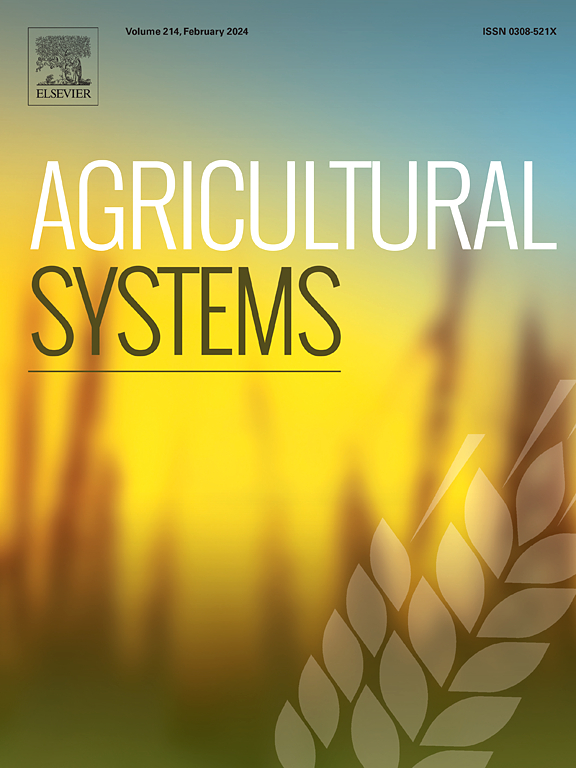Adoption without gains, and vice-versa: Exploring the disconnect between improved bean varieties and yield in Central America and Haiti through the lens of seed systems
IF 6.1
1区 农林科学
Q1 AGRICULTURE, MULTIDISCIPLINARY
引用次数: 0
Abstract
Context
Common beans (Phaseolus vulgaris L.) are vital for food security and rural livelihoods in Central America and Haiti. Over the past 30 years, R&D has focused on breeding resilient bean varieties to withstand climate change, pests, and diseases. However, the success of these innovations depends not only on variety development but also on efficient seed systems that deliver them to farmers—a crucial yet often overlooked factor in maximizing agricultural R&D benefits.
Objectives
This study evaluates the adoption of improved bean varieties and associated yield differences across Guatemala, Honduras, Nicaragua, and Haiti. It also assesses the extent to which current seed systems facilitate or constrain adoption and potential yield outcomes.
Methods
This study used a mixed-methods approach, combining DNA fingerprinting, farmer surveys, on-farm field trials, and expert interviews to assess adoption of improved varieties. Regression analysis was used to examine yield differences, controlling for observable factors.
Results
Adoption estimates ranged from 10 % (Nicaragua) to 77 % (Haiti). Only Nicaragua—despite low adoption—showed a significant yield gain (∼33 % at p < 0.05). In contrast, Guatemala, Honduras, and Haiti recorded no gains despite moderate to high adoption reported by experts (Honduras and Guatemala) or confirmed by DNA analysis (Haiti). DNA evidence reveals contamination in formal seed channels, while survey data and expert opinion suggest that limited support services may constrain performance.
Significance
Adoption alone is not a sufficient metric of success. Ensuring genetic integrity, local adaptation of varieties, and effective delivery systems is critical for translating research investment into yield benefits. Strengthening seed quality control, aligning bean breeding with farmer needs, and supporting informal systems are key to maximizing impact.

采用无收益,反之亦然:从种子系统的角度探讨中美洲和海地改良大豆品种与产量之间的脱节
普通豆类(Phaseolus vulgaris L.)对中美洲和海地的粮食安全和农村生计至关重要。在过去的30年里,研发部一直专注于培育抵御气候变化、病虫害的弹性豆类品种。然而,这些创新的成功不仅取决于品种的发展,还取决于将它们提供给农民的高效种子系统——这是最大化农业研发效益的一个关键因素,但往往被忽视。本研究评估了危地马拉、洪都拉斯、尼加拉瓜和海地采用改良豆类品种及其相关产量差异。它还评估了当前种子系统促进或限制采用和潜在产量结果的程度。方法本研究采用混合方法,结合DNA指纹、农民调查、农场田间试验和专家访谈来评估改良品种的采用情况。采用回归分析检验产量差异,控制可观察因素。结果采用率估计从10%(尼加拉瓜)到77%(海地)不等。只有尼加拉瓜——尽管采用率很低——显示出显著的产量增长(p <;0.05)。相比之下,危地马拉、洪都拉斯和海地尽管专家报告(洪都拉斯和危地马拉)或DNA分析(海地)证实了中度至高的采用率,但没有取得任何进展。DNA证据表明正规种子渠道受到污染,而调查数据和专家意见表明,有限的支持服务可能会限制业绩。重要性采用本身并不是衡量成功的充分标准。确保遗传完整性、品种的地方适应性和有效的交付系统对于将研究投资转化为产量效益至关重要。加强种子质量控制,使豆类育种与农民需求保持一致,并支持非正式系统是发挥最大影响的关键。
本文章由计算机程序翻译,如有差异,请以英文原文为准。
求助全文
约1分钟内获得全文
求助全文
来源期刊

Agricultural Systems
农林科学-农业综合
CiteScore
13.30
自引率
7.60%
发文量
174
审稿时长
30 days
期刊介绍:
Agricultural Systems is an international journal that deals with interactions - among the components of agricultural systems, among hierarchical levels of agricultural systems, between agricultural and other land use systems, and between agricultural systems and their natural, social and economic environments.
The scope includes the development and application of systems analysis methodologies in the following areas:
Systems approaches in the sustainable intensification of agriculture; pathways for sustainable intensification; crop-livestock integration; farm-level resource allocation; quantification of benefits and trade-offs at farm to landscape levels; integrative, participatory and dynamic modelling approaches for qualitative and quantitative assessments of agricultural systems and decision making;
The interactions between agricultural and non-agricultural landscapes; the multiple services of agricultural systems; food security and the environment;
Global change and adaptation science; transformational adaptations as driven by changes in climate, policy, values and attitudes influencing the design of farming systems;
Development and application of farming systems design tools and methods for impact, scenario and case study analysis; managing the complexities of dynamic agricultural systems; innovation systems and multi stakeholder arrangements that support or promote change and (or) inform policy decisions.
 求助内容:
求助内容: 应助结果提醒方式:
应助结果提醒方式:


